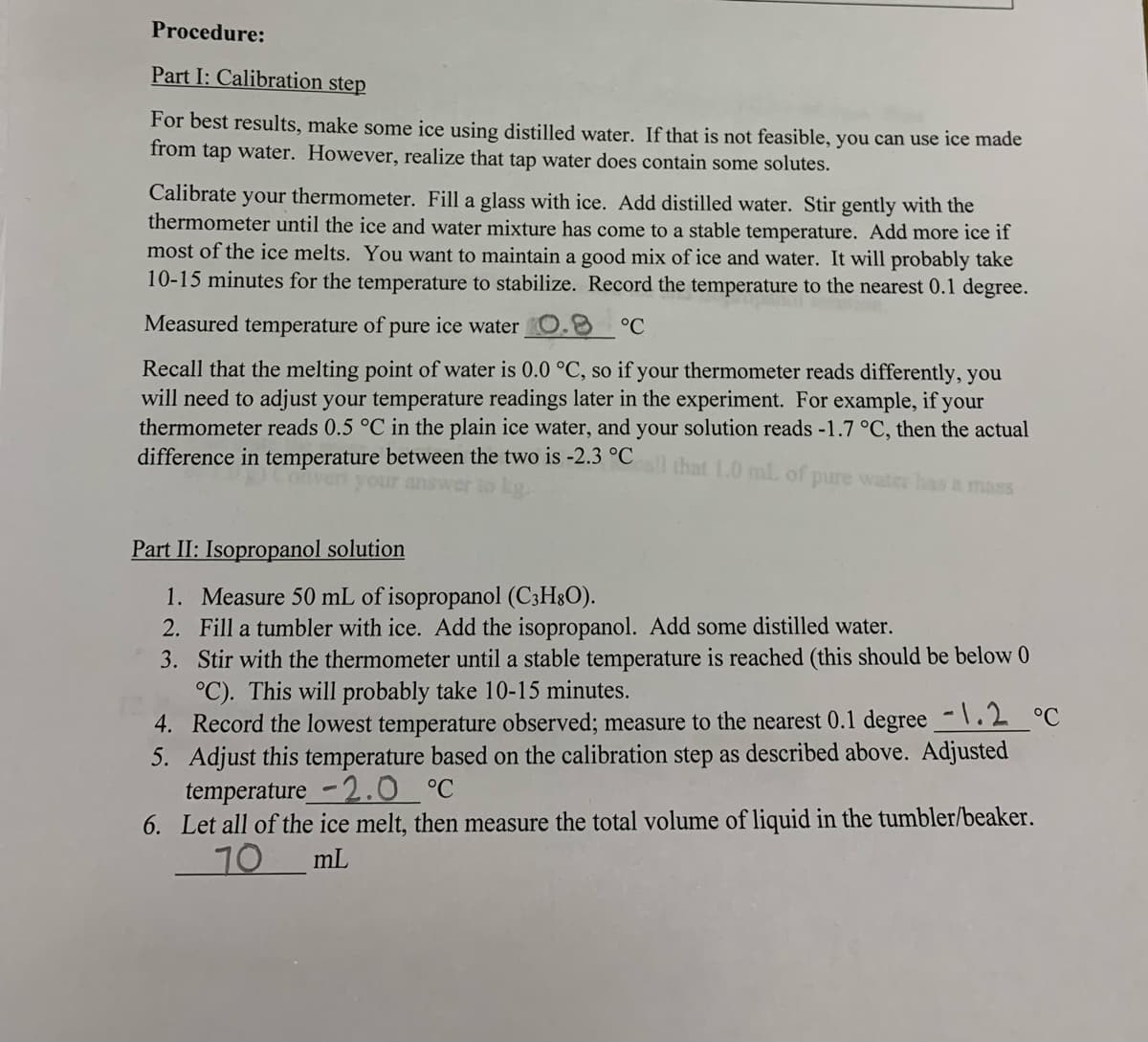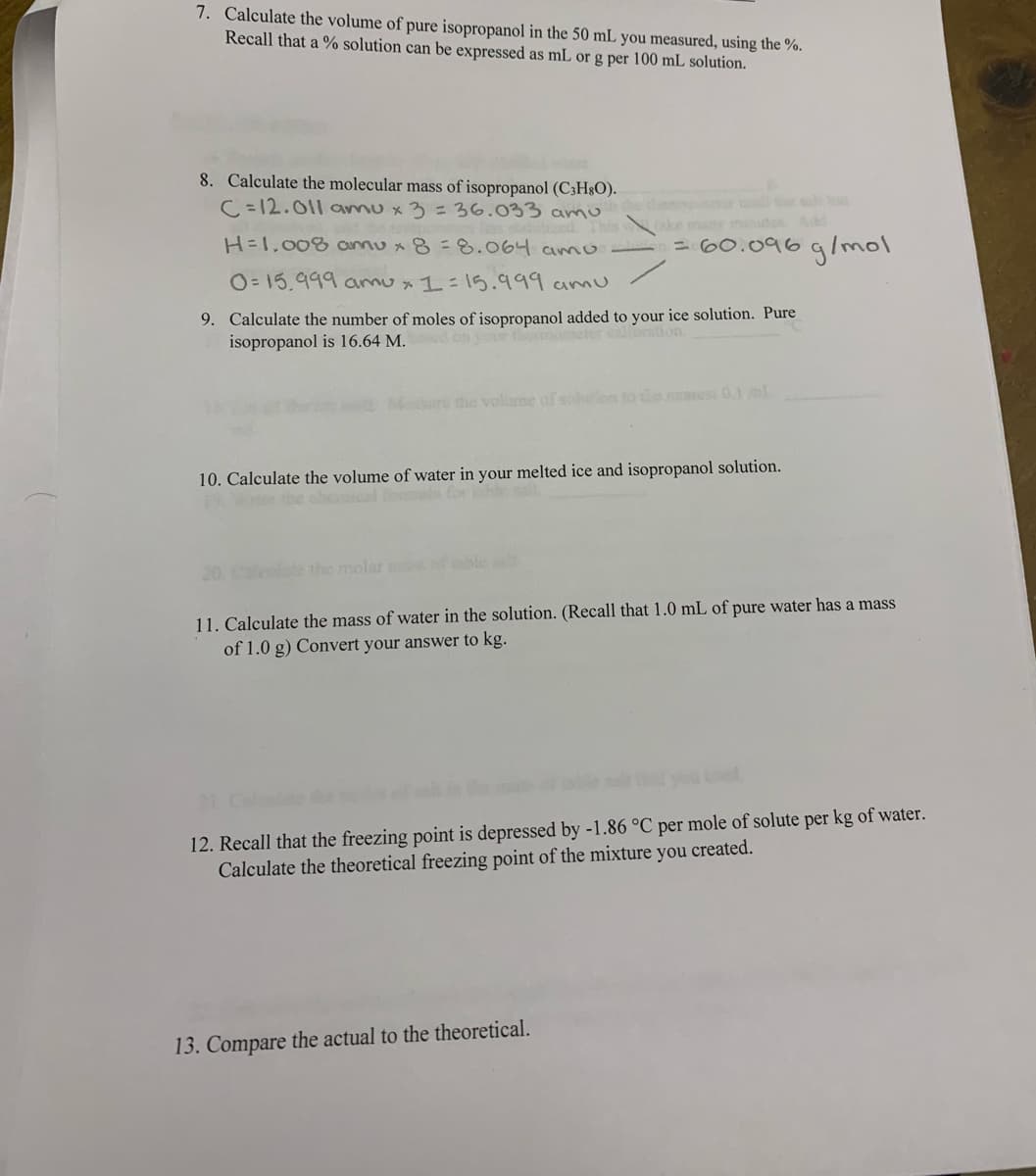Chemical Principles in the Laboratory
11th Edition
ISBN:9781305264434
Author:Emil Slowinski, Wayne C. Wolsey, Robert Rossi
Publisher:Emil Slowinski, Wayne C. Wolsey, Robert Rossi
Chapter6: Properties Of Hydrates
Section: Chapter Questions
Problem 1ASA: A student is given a sample of a pink manganese (II) chloride hydrate. She weighs the sample in a...
Related questions
Question
Based off information from the attachment, please help with #9 on second attachment

Transcribed Image Text:Procedure:
Part I: Calibration step
For best results, make some ice using distilled water. If that is not feasible, you can use ice made
from tap water. However, realize that tap water does contain some solutes.
Calibrate your thermometer. Fill a glass with ice. Add distilled water. Stir gently with the
thermometer until the ice and water mixture has come to a stable temperature. Add more ice if
most of the ice melts. You want to maintain a good mix of ice and water. It will probably take
10-15 minutes for the temperature to stabilize. Record the temperature to the nearest 0.1 degree.
Measured temperature of pure ice water
°C
Recall that the melting point of water is 0.0 °C, so if your thermometer reads differently, you
will need to adjust your temperature readings later in the experiment. For example, if your
thermometer reads 0.5 °C in the plain ice water, and your solution reads -1.7 °C, then the actual
difference in temperature between the two is -2.3 °C
that 1.0 mL of pure water has a mass
Part II: Isopropanol solution
1. Measure 50 mL of isopropanol (C3H3O).
2. Fill a tumbler with ice. Add the isopropanol. Add some distilled water.
3. Stir with the thermometer until a stable temperature is reached (this should be below 0
°C). This will probably take 10-15 minutes.
4. Record the lowest temperature observed; measure to the nearest 0.1 degree -\.2 °C
5. Adjust this temperature based on the calibration step as described above. Adjusted
temperature_-2.0 °C
6. Let all of the ice melt, then measure the total volume of liquid in the tumbler/beaker.
70
mL

Transcribed Image Text:7. Calculate the volume of pure isopropanol in the 50 mL you measured, using the %.
Recall that a % solution can be expressed as mL or g per 100 mL solution.
8. Calculate the molecular mass of isopropanol (C3H§O).
C. = 12.011 amu x 3 =36.033 amu
This ke many minutes Add
H=1,008 annu x 8 = 8.064 amO-
= 60.096gImol
O= 15,999 amux 1:15.999 amu
9. Calculate the number of moles of isopropanol added to your ice solution. Pure
isopropanol is 16.64 M.
on your thmumeter calbeation.
ru the volisne of solon to e ares 0.1ml
10. Calculate the volume of water in your melted ice and isopropanol solution.
9e the cheical us
20. e
the molar
11. Calculate the mass of water in the solution. (Recall that 1.0 mL of pure water has a mass
of 1.0 g) Convert your answer to kg.
12. Recall that the freezing point is depressed by -1.86 °C per mole of solute per kg of water.
Calculate the theoretical freezing point of the mixture you created.
13. Compare the actual to the theoretical.
Expert Solution
This question has been solved!
Explore an expertly crafted, step-by-step solution for a thorough understanding of key concepts.
Step by step
Solved in 2 steps

Knowledge Booster
Learn more about
Need a deep-dive on the concept behind this application? Look no further. Learn more about this topic, chemistry and related others by exploring similar questions and additional content below.Recommended textbooks for you

Chemical Principles in the Laboratory
Chemistry
ISBN:
9781305264434
Author:
Emil Slowinski, Wayne C. Wolsey, Robert Rossi
Publisher:
Brooks Cole

Chemical Principles in the Laboratory
Chemistry
ISBN:
9781305264434
Author:
Emil Slowinski, Wayne C. Wolsey, Robert Rossi
Publisher:
Brooks Cole